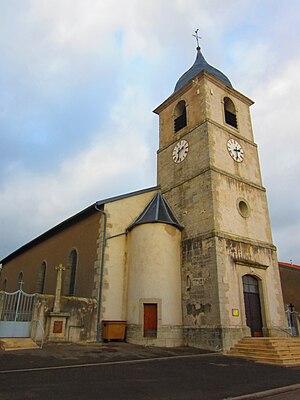Bréhain
| Bréhain | ||
|---|---|---|

|
|
|
| region | Grand Est | |
| Department | Moselle | |
| Arrondissement | Sarrebourg-Château-Salins | |
| Canton | Le Saulnois | |
| Community association | Saulnois | |
| Coordinates | 48 ° 55 ' N , 6 ° 32' E | |
| height | 244-314 m | |
| surface | 3.59 km 2 | |
| Residents | 107 (January 1, 2017) | |
| Population density | 30 inhabitants / km 2 | |
| Post Code | 57340 | |
| INSEE code | 57107 | |
 Saint-Gengoult church |
||
Bréhain is a French commune with 107 inhabitants (as of January 1, 2017) in the Moselle department in the Grand Est region (until 2015 Lorraine ). It belongs to the arrondissement of Sarrebourg-Château-Salins , to the canton of Le Saulnois and to the communal association Communauté de communes du Saulnois .
geography
Bréhain is located in the Saulnois on the upper reaches of the French Nied , 35 kilometers southeast of Metz and 25 kilometers southwest of Saint-Avold at an altitude between 244 and 314 meters above sea level between the neighboring communities of Château-Bréhain in the southwest Villers-sur-Nied in the north and Marthille in the northeast. The municipal area covers 3.59 km² (359 hectares).
history
The place name Bréhain was first mentioned in 1169 as Berchem , in 1178 it appeared as Brehem. The place name originated from the Germanic word “ mountain ” and the place name ending “ -heim ”. In 1450 the German name Bruchheim is documented.
Before the French Revolution (1789–1799), Bréhain belonged to Château-Bréhain. The fiefdom of Château-Bréhain belonged to the barony of Viviers , which in turn belonged to the Marquisate of Pont-à-Mousson from the 14th century . In 1698 Pont-à-Mousson became a Bailliage of the Duchy of Bar . From 1751 the village belonged to the Bailliage of Château-Salins .
In 1793, Bréhain received the status of a municipality as Brehain in the course of the French Revolution and in 1801, as Brehain, the right to local self-government. From 1801 to 1871 it belonged to the former Meurthe department , which was renamed the Meurthe-et-Moselle department in 1871 . In 1871 the community was incorporated into the newly created realm of Alsace-Lorraine of the German Empire due to changes in territory due to the course of the Franco-German War (1870–1871) . The realm of Alsace-Lorraine existed until the end of the First World War (1914–1918) and was then dissolved. At that time, Bréhain was in the Moselle department, this change was retained in 1918 when Moselle was again assigned to France. As a French-speaking town, Bréhain was one of the last 247 communities whose name was Germanized on September 2, 1915. The name was changed to "Bruchheim" and was the official place name until 1918.
Population development
| year | 1962 | 1968 | 1975 | 1982 | 1990 | 1999 | 2007 |
| Residents | 101 | 101 | 106 | 80 | 72 | 75 | 95 |
coat of arms
The municipality's coat of arms is red with a golden lance that stands upright in the middle and rises from the silver waves of a river. The lance is surrounded by two silver salmon , which are represented with their backs to the lance. The salmon correspond to the coat of arms of the Barony of Viviers. The lance (stick) and river (source) are attributes of Saint Gangolf , the patron saint of the place.
Infrastructure
The nearest airport is Metz-Nancy-Lorraine Airport , located 22.2 kilometers northwest of Bréhain. There is a driveway to Route nationale 74 (RN74) southeast of the town center .
Web links
Individual evidence
- ↑ a b Annuaire-Mairie.fr (French)
- ^ Ernest Nègre: Toponymie générale de la France . tape 2 . Librairie Droz, 1996, ISBN 978-2-600-00133-5 , pp. 724 ( in Google Books [accessed March 29, 2010]). (French)
- ^ Settlement names between late antiquity and the early Middle Ages. The -iacum names of the Roman province of Belgica Prima, Monika Buchmüller-Pfaff, 1990, p. 813.
- ^ Henri Lepage: Dictionnaire topographique du département de la Meurthe . In: Société d'archéologie lorraine et du Musée historique lorrain (ed.): Dictionnaire topographique de la France . 6th edition. tape 14 , no. 18 . Imprimerie impériale, Paris 1862, p. 23 + 29 f. +110 + 157 ( in Google Books [accessed on March 26, 2010]). (French)
- ↑ Des villages de Cassini aux communes d'aujourd'hui (French). Accessed March 24, 2010
- ↑ Les 247 dernières communes à noms français, débaptisées seulement le 2 septembre 1915 (French)
- ↑ Union des Cercles Génealogiques Lorrains (French)
